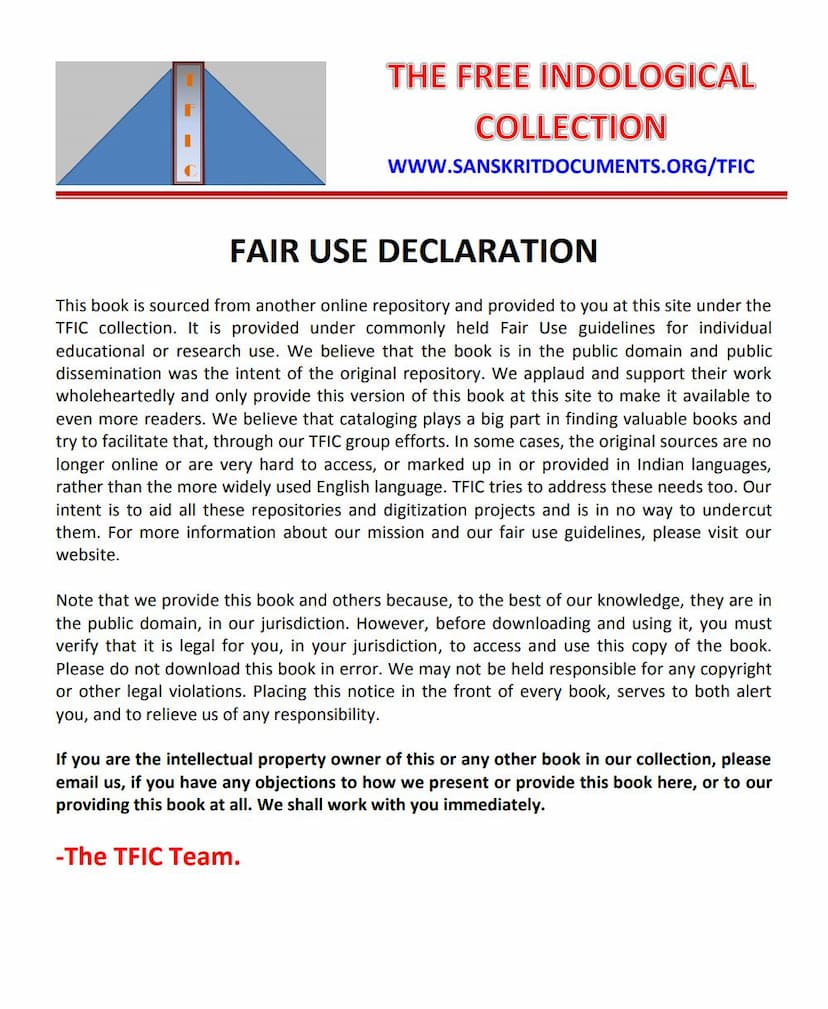Jaina Monuments And Places First Class Importance
Added to library: September 2, 2025

Summary
This document, "Jaina Monuments and Places of First Class Importance" by T. N. Ramachandran, is a comprehensive overview of significant sites and artistic expressions related to Jainism across India. Published by Veer Shasan Sangh Calcutta, it serves as a presidential address delivered at the All-India Jaina Sasana Conference in 1944, commemorating the 2500th anniversary of Lord Mahavira Swami's first preaching.
The book is meticulously organized, covering various geographical regions and artistic manifestations of Jainism.
Key Areas Covered:
North India:
- Rajagriha: Highlighted as a central location in Jainism, where Mahavira spent significant periods and many of his disciples attained nirvana. It discusses the city's historical names, its rulers, and the prominent hills surrounding it, including Vaibharagiri and Vipulagiri, which held religious significance for Jainas. The presence of Jaina inscriptions and temples is noted.
- Bihar - Barabar Hills: Focuses on rock-cut caves, including the Lomas Rishi Cave, attributed to the Ājīvikas (a sect closely related to Jainism) during the Maurya period. The craftsmanship and architectural style are discussed.
- Mathura: Examines the significant development of plastic art in Mathura, with a focus on pre-Kushana and Kushana period sculptures. It details the evolution of the Mathura school of art, mentioning Jaina āyāgapātas (votive tablets) and the influence of Hellenistic art. The Kankali Tila site is highlighted as a major Jaina center.
- Orissa: Discusses the rock-hewn caves of Udayagiri and Khandagiri, which were excavated and inhabited by Jainas. The Rani Gumpha is noted for its elaborate decorations illustrating Jaina narratives. The significant inscription of King Kharavela in the Hathigumpha cave is also mentioned.
- Khajuraho: Briefly mentions the Jaina temples at Khajuraho, contemporary with the Hindu temples, and notes their architectural similarity and artistic details.
- Mount Abu: Celebrates the exquisite Jaina temples, particularly the Dilwara temples (Vimala Shah and Tejahpala), known for their intricate marble carvings, unique ceilings, and delicate craftsmanship.
- Taranga, Girnar, and Satrunjaya: These are described as important Jaina pilgrimage sites. Girnar and Satrunjaya are highlighted as temple-cities situated on hills, containing numerous shrines and significant architectural structures.
- Ranpur and Parsvanath: Mentions other picturesque Jaina temple groups.
- Pawapuri: Identified as the place of Mahavira's nirvana, located near Rajagriha.
- Jainism in East Bengal: Discusses the limited evidence of Jainism in this region, mentioning a Jaina vihara and the influence of Nirgranthas (Jainas) in ancient times.
South India: The book dedicates a substantial portion to the history and monuments of Jainism in South India, detailing its spread and patronage by various dynasties.
- History of Jainism in South India: Traces the arrival of Jainism with figures like Chandragupta Maurya and preachers like Kalakacharya and Visakhacharya. It emphasizes the significant role of Kundakundacharya and the influence of Jainism in Tamil literature.
- Patronage: Details the patronage Jainism received from various ruling dynasties, including Pallavas, Pandyas, Western Chalukyas, Gangas, Rashtrakutas, Kalachuryas, and Vijayanagara kings. It notes instances of persecution and conversion, as well as periods of significant support.
- Trichinopoly: Focuses on the rock-cut caves with beds and epigraphs, identifying the ancient name 'Chirapalli' with its Jaina associations. The inscriptions, including those possibly bearing the name of Mahendravarman I, are discussed.
- Tiruparuttikunram (Jina-Kanchi): Explores this significant Jaina center, a vidyasthana (seat of learning). It highlights the role of Jaina sages, the propagation of the Digambara sect, and the intellectual contributions of figures like Akalanka and Mallisena.
- Painting:
- General: Notes the scarcity of early Jaina painting remains, with traces found in caves like Jogimara and Udayagiri.
- Sittanṇavasal: Details the significant fresco paintings on the ceiling of the Jaina cave temple, attributed to the Pallava king Mahendravarman I. The artistic style, themes (including samavasarana), and the identification of figures are discussed. The preservation challenges and vandalism faced by these paintings are also noted.
- Tirumalai: Describes paintings from the 11th century AD, depicting samavasarana scenes, geometrical patterns, and figures.
- Sravana Belgola: Mentions paintings found in the Jaina matha, illustrating the lives of Tirthankaras and kings.
- Jaina Painted Manuscript Covers: Discusses the importance of painted covers of Jaina manuscripts, particularly those of the Kalpasutra and Kalakacharya Katha. It outlines three periods of development in Jaina miniature painting (archaic, Mughal influence, and Rajput influence) and describes their decorative value, technique, and symbolism.
- Jaina Iconography:
- Philosophy: Clarifies that Jainism is not atheistic, believing in Tirthankaras and other divine beings, but not a creator god. The concept of souls attaining godhood through spiritual pursuit is central.
- Deities: Explains the Jaina pantheon, distinguishing between Siddhas (emancipated souls) and devas (celestial beings). It notes the influence of Hindu iconography and the integration of Brahmanical deities in inferior positions.
- Tirthankaras: Details the characteristics of the 24 Tirthankaras of the present age, including their typical seated and standing postures, and the distinguishing lanchhanas (emblems). The differences between Digambara (nude) and Svetambara (clothed) images are mentioned.
- Symbolism: Discusses the significance of the Pañcha-paramēshthins and other symbolic representations like the chakra.
- Metal Images:
- Discusses metal images found at Paharpur, Orissa, and Gwalior, highlighting Tirthankara figures and their stylistic features.
- Details South Indian bronzes from the Bellary and North Kanara districts, identifying various Tirthankaras and associated deities, and noting inscriptions that help in dating these artifacts.
- Hampi: Mentions the Jaina temples in Hampi, highlighting their picturesque settings and inscriptions that attest to the importance of the Jaina community during the Vijayanagara period.
- Conclusion: Summarizes the findings, emphasizing the prevalence of rock-cut sculptures in southern districts, sculptures in the round, colossal statues of Bahubali, manastambhas, structural temples in Dravidian and Nagara styles, and unique memorial stones (nisidis). The book concludes by noting the prevalence of metal images for processional use.
In essence, the book is a scholarly and extensive catalog of Jaina heritage, tracing the historical presence, artistic achievements, and religious significance of Jainism across diverse regions of India through its monuments, sculptures, paintings, and iconography.